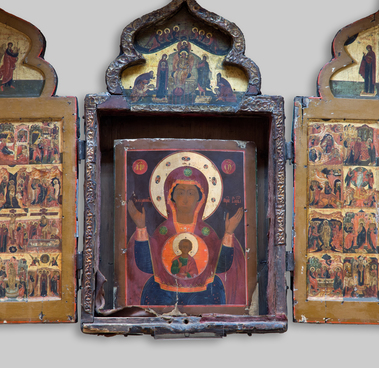LefauchEUx Revolvers are named after the French designer CasimIr LefauchEUx. The first version of the revolver equipped with a pin cartridge was adopted in France in 1853. France was the first country in the world to introduce a revolver into its army.
The BereznikI Museum keeps a revolver of the 1858 year model - this is the oldest exhibit in the museum’s collection of weapons. The 1858 model has a front sight, an octagonal barrel, a handle that is convenient for the shooter and a side trigger for a fire cartridge. The revolver magazine is designed for six cartridges with a caliber of 11.5 millimeters. The weapon weighed 600 grams.
There is no automatic ejector in the design of the LefauchEUx revolver: it was possible to remove the empty cartridge case from the cylinder only using a rod, an extractor, through the open flap of the revolver cylinder. You could push out one cartridge case at a time. It took a lot of time for shooter to replace the cartridge in the cylinder.
In Russia, LefauchEUx revolvers were tested in 1859 at the officer’s rifle school. They were recognized as the best among the models produced at that time due to their simplicity and the use of a unified cartridge. Official deliveries from abroad began in the 1860s to re-equip the lower ranks of the gendarme corps.
Revolvers LefauchEUx, along with other models - for example the Colt, were recommended to be acquired by officers at their own expense instead of the standard smoothbore pistols of the 1849 model unpopular in the troops.
The revolver was submitted to the museum in 1955. In 1966-1967, an unknown person stole the exhibit from the museum, and in 1969 the deputy director of the BereznikI vocational school No. 8 found it at a student. The revolver was confiscated and returned to the museum with the words ‘it is not worth of a story’ - by this time the ‘thief’ was called up for military service. The student surname was never announced.
The student of vocational school No. 8 tried to bring the old empty revolver to a satisfactory condition. He made the cheek pieces out of wood, i.e. the lining on the handle of the revolver. Using screws and nuts, he reinforced the trigger mechanism of the revolver - the trigger, with nuts he secured the revolver cylinder.
The BereznikI Museum keeps a revolver of the 1858 year model - this is the oldest exhibit in the museum’s collection of weapons. The 1858 model has a front sight, an octagonal barrel, a handle that is convenient for the shooter and a side trigger for a fire cartridge. The revolver magazine is designed for six cartridges with a caliber of 11.5 millimeters. The weapon weighed 600 grams.
There is no automatic ejector in the design of the LefauchEUx revolver: it was possible to remove the empty cartridge case from the cylinder only using a rod, an extractor, through the open flap of the revolver cylinder. You could push out one cartridge case at a time. It took a lot of time for shooter to replace the cartridge in the cylinder.
In Russia, LefauchEUx revolvers were tested in 1859 at the officer’s rifle school. They were recognized as the best among the models produced at that time due to their simplicity and the use of a unified cartridge. Official deliveries from abroad began in the 1860s to re-equip the lower ranks of the gendarme corps.
Revolvers LefauchEUx, along with other models - for example the Colt, were recommended to be acquired by officers at their own expense instead of the standard smoothbore pistols of the 1849 model unpopular in the troops.
The revolver was submitted to the museum in 1955. In 1966-1967, an unknown person stole the exhibit from the museum, and in 1969 the deputy director of the BereznikI vocational school No. 8 found it at a student. The revolver was confiscated and returned to the museum with the words ‘it is not worth of a story’ - by this time the ‘thief’ was called up for military service. The student surname was never announced.
The student of vocational school No. 8 tried to bring the old empty revolver to a satisfactory condition. He made the cheek pieces out of wood, i.e. the lining on the handle of the revolver. Using screws and nuts, he reinforced the trigger mechanism of the revolver - the trigger, with nuts he secured the revolver cylinder.



